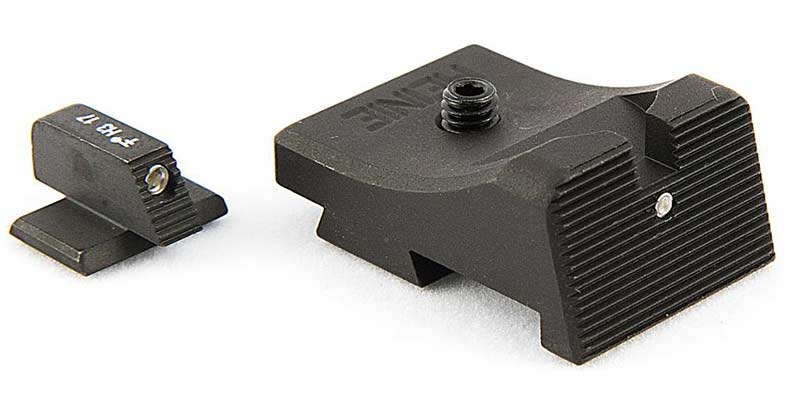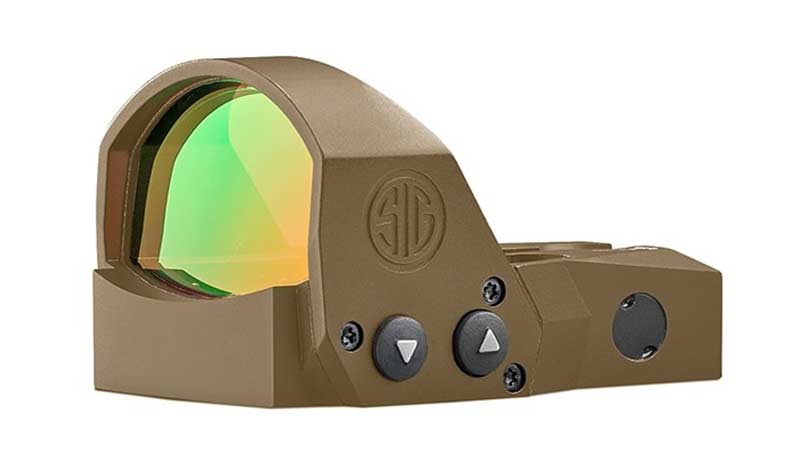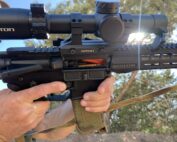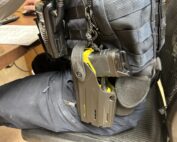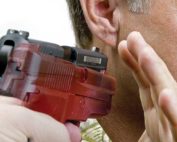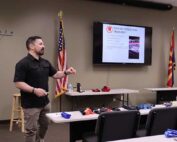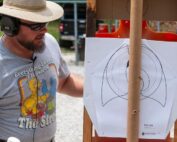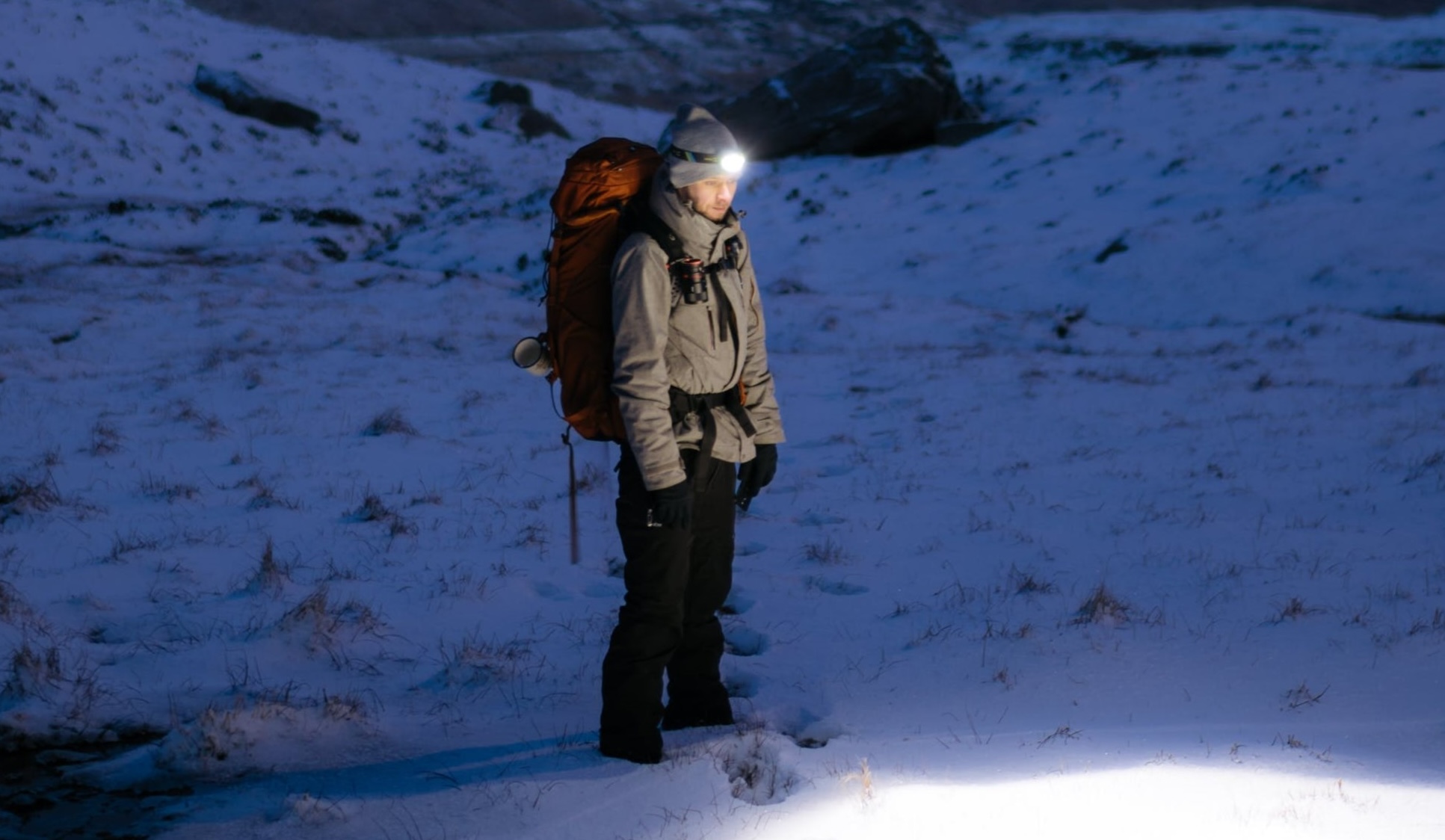
AHSO20-Sig-Sauer-Romeo1PRO-Red-Dot-Sight
When you stop to think about it, we all have different eyesight. Some of us are nearsighted, farsighted, color blind, or just have older and more tired eyeballs. Shooting conditions and backgrounds are all over the map. Do you do most of your shooting in daylight conditions or do you own a handgun for concealed carry or home defense? These variables make the right choice of sight important — and personal.
Upgrading iron sights on an existing pistol is usually a straightforward process. With a few tools and some patience, you can do it at home. If you aren’t confident in the job, most gun dealers can handle the task for you. If you have a newer optics-ready pistol, the world is your oyster.
Here are a handful of our favorite sight options.
Shield RMSc
There are two things you need to know about the Shield RMSc red dot sights. First, they’re compact and perfect for the fresh crop of smaller pistols like the Springfield Armory Hellcat. Second, they’re tough. Rather than using glass for sight windows, the RMSc uses … not glass. The result is a sight that can take 10 times more shock impact than a traditional glass red dot sight. That’s great for a defensive pistol that you’ll tote around all the time.
The RMSc uses a single CR2032 battery, available most anywhere. With it, you’ll get a continuous two to three years of use. There are no on or off switches to worry about, so it’s great for carry and home-defense handguns. The RMSc gets such long battery life by being smart about its brightness level. Sensing ambient light conditions, it increases or decreases the intensity of the red dot as needed — all automatically.
You can order the RMSc in two dot configurations: Four and eight MOA.
For more info: www.shieldpsd.com
XS Big Dot DXT2 Sights
I like big dots and I cannot lie. I’m constantly trying new sights because this is not just an adventure, it’s a job. But for many of my pistols I keep coming back to XS Big Dot sights, and in particular, the new DXT2 models.
Stop and consider what you hear when you think about your last “instructor voice” experience. I’ll bet it was something like “focus on the front sight!” That’s what the big dots are all about. Forget traditional post and notch, these sights use a shallow “V” ramp for the rear sight with a vertical Tritium bar just below the “V.” When paired with a jumbo-sized round front sight, your objective is to “dot the ‘I’ to get a proper sight picture.” The system is blazing fast. Stick the dot on the target and the rear sight bar settles into place under the circle. Given its size, you literally can’t miss it. Astronauts on the International Space Station will probably see it coming out of your holster.
The new and nifty thing about the DXT2 is the enhanced dot technology. The front sight is optimized for all three lighting conditions: daylight, transient light and low light. You can choose either yellow or orange for the paint color around the center Tritium vial depending on what you see better and how you prefer your front sight color to contrast with different backgrounds. I prefer orange for general use daylight conditions. That same paint is photoluminescent, so it picks up light as you go about your business. When moving into transient light, say walking into a building, the paint glows bright. When conditions are darker, the Tritium takes over, giving that epic front sight a hard-to-miss glow.
For more info: xssights.com
Trijicon SRO
The first thing I noticed about the Trijicon SRO Red Dot Sights was the size. They’re huge. The second thing I noticed about the Trijicon SRO Red Dot Sights was the size. They’re not any bigger than other handgun red dot sights. Huh?
The shape of the viewing area is one feature that makes the SRO sights special. The window is near round, as is the protective housing around the sight glass. This shape presents more “usable” space for your eyes, so the optic “appears” to be huge.
However, when you set the whole red dot unit next to another, it’s not actually significantly larger, if at all. The bottom line is that the round viewing area gives you more usable space.
There are a couple of other features making this sight worthy of serious consideration. It comes with legendary Trijicon durability, so it’ll stand up to hard daily use either in defensive applications or on the competition fields. The CR2032 battery loads from the top, so you don’t have to remove the sight from the pistol to change batteries. No more re-zeroing with every battery change. Not that battery swaps are a big deal — the SRO runs for about three years continuously. Last but not least, the SRO features two brightness modes. The automatic mode adjusts dot intensity based on ambient light conditions. This is great for carry or home defense. The manual mode allows you to choose from eight different brightness settings. This is great for competition where you won’t want anything changing as you run through a course.
The SRO is available with three different dot sizes: 1.0, 2.5, and 5.0 MOA.
One more thing. The SRO is waterproof to 10 feet, so if you plan on doing any underwater beach assaults, that’s fine, just don’t go too deep.
For more info: www.trijicon.com
Heinie SlantPro Handgun Sights
Sights can make all the difference. Whether shooting for competition, self-defense, or just plinking, the sights not only align the bore to the target, they can make your job as a shooter easier, or in too many cases, harder. The Heinie “Straight Eight” concept definitely falls into the make your work easier camp.
I asked the folks at Heinie which model they recommend for carry and here’s what they had to say. “Heinie Sights has designed a superior conceal carry sight system called the ‘SlantPro.’ The rear sight is slightly slanted forward and has rear serrations. The forward angled slant combined with the rear serrated face helps eliminate and defuse glare from any lighting source. The sight is virtually snag free with all edges and corners beveled or rounded. It is our number one recommended Heinie design for conceal carry. The Heinie SlantPro Sight Set is available without any markings (all black) or with the legendary Heinie Straight Eight Night Sight design.”
I like the 1911 Mil-Spec SlantPro Tritium Straight Eight Sight Set. This package comes with the SlantPro contoured rear sight for snag-free holstering and drawing. The rear face is serrated to reduce glare and the rear notch is set atop a single Tritium dot. Stack this one with the Tritium front sight and you’re ready to go. No confusing three dot sight pictures in low light. Most people find the “straight eight” style faster.
For more info: www.heinie.com
SIG SAUER Romeo1PRO
The first thing you’ll likely notice about the SIG SAUER Romeo1PRO Red Dot Sight is the window size. Using a combination of straight sides and a rounded top surface, you have a large sight picture window. The lens is treated with scratch-resistant material to provide years of red dot clarity, even when your optic is exposed to the hard knocks and dings of daily carry.
The Romeo1PRO also runs 75 percent of forever on a fresh battery because it uses motion sensing technology to turn the dot on and off. When sitting in the safe or other stationary location, the red dot powers down. The instant the gun moves, it turns back on. As far as you’re concerned, it’s always on. In the six months I’ve been testing one on a SIG SAUER P320 XCompact, I’ve not yet caught the red dot sleeping when it should be awake. The optic uses a single CR1632 battery for its power source. When times comes to swap it out, you’ll be happy the battery compartment is accessible from the top so you don’t have to remove and re-zero your red dot.
The Romeo1PRO is available in three varieties at this time: black with 3 MOA dot, black with 6 MOA dot and flat dark earth with 6 MOA dot.
Even though it has the motion sensing feature, you can manually choose brightness levels from 10 daytime modes and two night vision compatible modes.
One more thing. Depending on your pistol, you may benefit from the rear “iron sight” notch cut into the back edge of the Romeo1PRO. When mounted on the P320 XCompact, for example, the optic takes the place of the rear iron sight but gives you a co-witnessed backup sight option. The rear notch and front post are visible in the bottom of the red dot lens. If the electronics fail or become damaged, you still have a viable manual sighting option.
For more info: www.sigsauer.com



